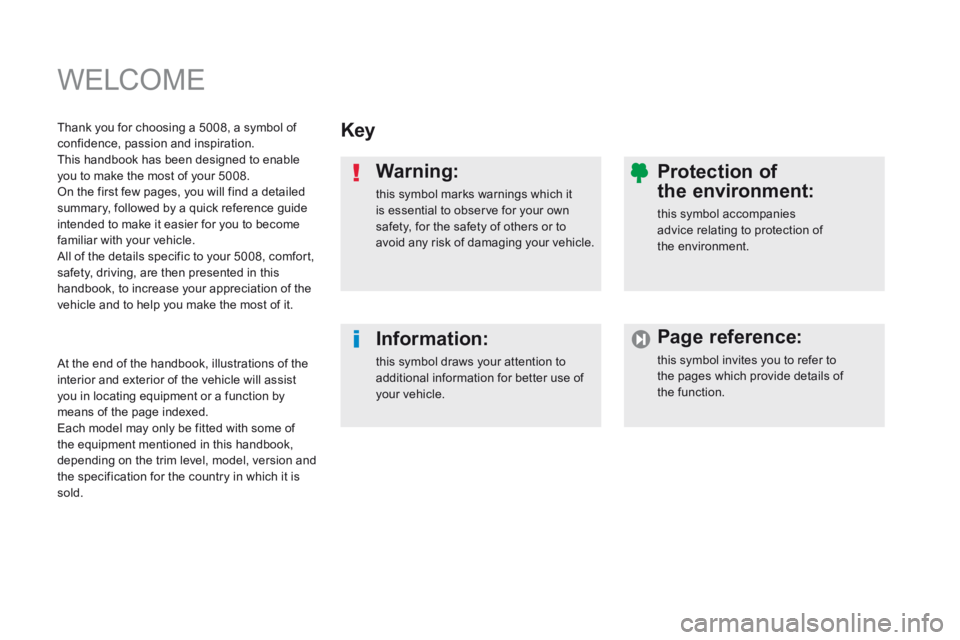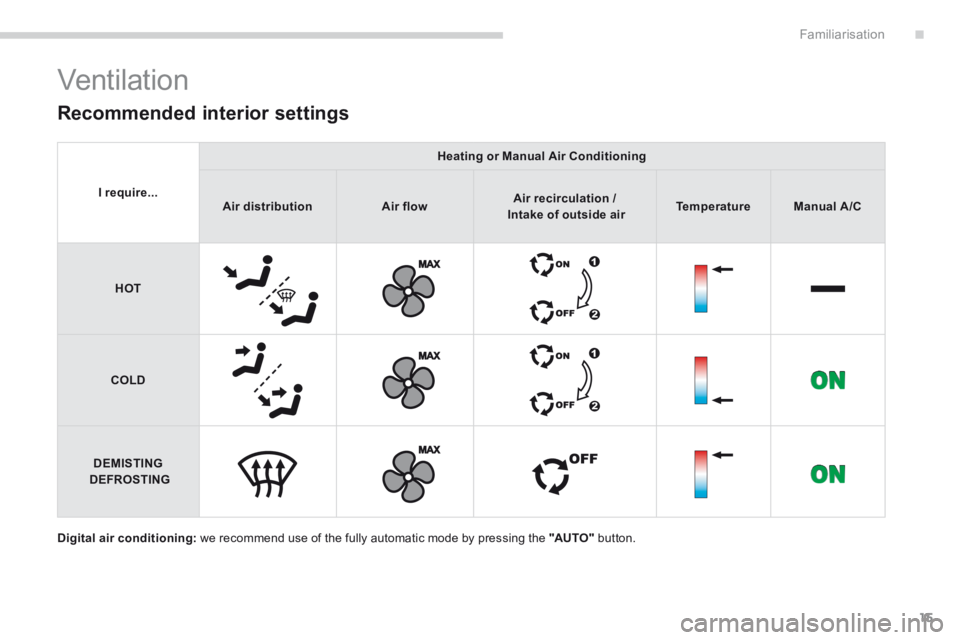2013.5 PEUGEOT 5008 ECO mode
[x] Cancel search: ECO modePage 3 of 404

WELCOME
Key
Warning:
this symbol marks warnings which it is essential to observe for your own safety, for the safety of others or to avoid any risk of damaging your vehicle.
Information:
this symbol draws your attention to additional information for better use of your vehicle.
Protection of
the environment:
this symbol accompanies advice relating to protection of the environment.
Page reference:
this symbol invites you to refer to the pages which provide details of the function.
Thank you for choosing a 5008, a symbol of confidence, passion and inspiration. This handbook has been designed to enable you to make the most of your 5008. On the first few pages, you will find a detailed summary, followed by a quick reference guide intended to make it easier for you to become familiar with your vehicle. All of the details specific to your 5008, comfort, safety, driving, are then presented in this handbook, to increase your appreciation of the vehicle and to help you make the most of it.
At the end of the handbook, illustrations of the interior and exterior of the vehicle will assist you in locating equipment or a function by means of the page indexed. Each model may only be fitted with some of the equipment mentioned in this handbook, depending on the trim level, model, version and the specification for the country in which it is sold.
Page 5 of 404

.
.
Contents
Direction indicators 152Hazard warning lamps 152Hor n 152Tyre under-infl ation detection 153ESC system 155Front seat belts 158Airbags 162
Safety
Electric parking brake 166Hill start assist 170Head-up display 173Distance alert 175Speed limiter 178Cruise control 181Manual gearbox 184Gear shift indicator 185Electronic gearbox 186Automatic gearbox 191Stop & Start 195Parking sensors 198Reversing camera 200Parking space sensors 201
Driving
Emergency or assistance 265PEUGEOT Connect Media Navigation (NG4 3D) 269PEUGEOT Connect Navigation (RT6) 313PEUGEOT Connect Sound (RD5) 367
Audio equipment and telematics
Visual search
Alphabetical index
Bonnet
204Running out of fuel (Diesel) 205Petrol engines 206Diesel engines 207Checking levels 208C h e c k s 2 11
Checks
Temporary puncture repair kit 213Changing a wheel 223Snow chains 230Changing a bulb 231Changing a fuse 23712 V battery 244Energy economy mode 247Changing a wiper blade 248Towing the vehicle 248Towing a trailer 250Fitting roof bars 252Very cold climate screen 253Accessories 254
Practical information
Petrol engines 256Petrol weights 257Diesel engines 258Diesel weights 259Dimensions 263Identifi cation markings 264
Technical data
Page 17 of 404

.Familiarisation15
Digital air conditioning: we recommend use of the fully automatic mode by pressing the "AUTO" button.
Ventilation
Recommended interior settings
I require...
Heating or Manual Air Conditioning
Air distributionAir flowAir recirculation / Air recirculation / Air recirculation / Intake of outside airTemperatureManual A/C
HOT
COLD
DEMISTING DEFROSTING
Page 22 of 404

195
Familiarisation
20
Driving safely
Stop & Start
Going into engine STOP mode
The "ECO" warning lamp comes on in the instrument panel and the engine automatically goes into standby, w ith
an electronic gearbox: at speeds below 5 mph (8 km/h), press the brake pedal or put the gear lever in position N .
In some circumstances, STOP mode may not be available; the "ECO" warning lamp flashes for few seconds, then goes off.
Going into engine START mode
The "ECO" warning lamp goes off and the engine restarts with an electronic gearbox :
In some circumstances START mode may be invoked automatically; the "ECO" warning lamp flashes for a few seconds, then goes off.
Deactivation / Reactivation
You can deactivate the system at any time by pressing the "ECO OFF" button; the warning lamp in the button comes on.
The system is reactivated automatically at every new start using the key.
Before refuelling or doing anything under the bonnet, you must switch off the ignition using the key.
- gear lever in position A or M , release the brake pedal, - or with the gear lever in position N and the brake pedal released, move the gear lever to position A or M , - or engage reverse gear.
Page 25 of 404

.
178181
Familiarisation23
Driving safely
Speed limiter "LIMIT"
1. Limiter mode Selection / Off. 2. Decrease the programmed value. 3. Increase the programmed value. 4. Speed limiter On / Off.
Cruise control "CRUISE"
1. Cruise control mode Selection / Off. 2. Programme a speed / Decrease the programmed value. 3. Programme a speed / Increase the programmed value. 4. Cruise control Off / Resume.
Display in the instrument panel
The cruise control or speed limiter mode appears in the instrument panel when it is selected.
Cruise control
Speed limiter
The values must be set with the engine running. In order to be programmed or activated, the vehicle speed must be higher than 25 mph (40 km/h), with at least fourth gear engaged on the manual gearbox (second gear for an electronic or automatic gearbox).
Page 27 of 404

.Familiarisation25
Eco-driving
Optimise the use of your
gearbox
With a manual gearbox, move off gently and change up without waiting. During acceleration change up early.
With an automatic or electronic gearbox, give preference to automatic mode and avoid pressing the accelerator pedal heavily or suddenly.
The gear shift indicator invites you engage the most suitable gear: as soon as the indication is displayed in the instrument panel, follow it straight away. With an electronic or automatic gearbox, this indicator appears only in manual mode.
Drive smoothly
Maintain a safe distance between vehicles, use engine braking rather than the brake pedal, and press the accelerator progressively. These practices contribute towards a reduction in fuel consumption and CO2 emissions and also helps reduce the background traffic noise.
If your vehicle has cruise control, make use of the system at speeds above 25 mph (40 km/h) when the traffic is flowing well.
Remember to make use of equipment that can help keep the temperature in the passenger compartment down (sunroof and window blinds...). Switch off the air conditioning, unless it has
automatic regulation, as soon as the desired temperature is attained. Switch off the demisting and defrosting controls, if not automatic. Switch off the heated seat as soon as possible.
Switch off the headlamps and front foglamps when the level of light does not require their use.
Avoid running the engine before moving off, particularly in winter; your vehicle will warm up much faster while driving.
Eco-driving is a range of everyday practices that allow the motorist to optimise their fuel consumption and CO2 emissions.
As a passenger, if you avoid connecting your multimedia devices (film, music, video game...), you will contribute towards limiting the consumption of electrical energy, and so of fuel. Disconnect your portable devices before leaving the vehicle.
Control the use of your
electrical equipment
Before moving off, if the passenger compartment is too warm, ventilate it by opening the windows and air vents before using the air conditioning. Above 30 mph (50 km/h), close the windows and leave the air vents open.
Page 32 of 404

Monitoring
30
Left-hand direction indicator
flashing with buzzer. The lighting stalk is pushed down.
Right-hand direction indicator
flashing with buzzer. The lighting stalk is pushed up.
Operation indicator lamps
If one of the following indicator lamps comes on, this confirms that the corresponding system has come into operation.
Warning lampis onCauseAction/Observations
Sidelamps fixed. The lighting stalk is inthe "Sidelamps" position.
Indicator and warning lamps
When the ignition is switched on
Certain warning lamps come on for a few seconds when the vehicle's ignition is switched on. When the engine is started, these same warning lamps should go off. If they remain on, before moving off, refer to the information on the warning lamp concerned.
Associated warnings
The illumination of certain warning lamps may be accompanied by an audible signal and a message in the multifunction screen.
Visual indicators informing the driver that a system is in operation (operation or deactivation indicator lamps) or of the occurrence of a fault (warning lamp).
The warning lamps may come on continuously (fixed) or flash. Certain warning lamps may come on in one of two different modes. Only by
relating the type of illumination to the operating status of the vehicle can it be ascertained whether the situation is normal or whether a fault has occurred.
Page 34 of 404

Monitoring
32
Warning lampis onCauseAction/Observations
Deactivation of the automatic functions of the electric parking brake
fixed. The "automatic application" (on switching off the engine) and "automatic release" functions are deactivated or faulty.
Activate the function (according to country) via the vehicle configuration menu or contact a PEUGEOT dealer or a qualified workshop if automatic application / release is not possible. The parking brake can be released manually using the emergency release procedure. For more information on the electric parking brake, refer to the corresponding section.
Foot on the brake pedal fixed. The brake pedal must be pressed. Press the brake pedal to start the engine with an electronic gearbox (lever in position N ) or automatic gearbox (lever in position P ). If you wish to release the parking brake without pressing the brake pedal, this warning lamp will remain on.
flashing. In the case of an electronic gearbox, if you hold the vehicle on an incline using the accelerator for too long, the clutch overheats.
Use the brake pedal and/or the electric parking brake.
Parking space sensors fixed. The parking space sensors function is active. Press the corresponding button to deactivate it.
flashing. The system is measuring the space. Once the measurement has been done, the warning lamp comes on fixed again.
Stop & Star t fixed. When the vehicle stops (red lights, traffic jams, ...) the Stop & Start system has put the engine into STOP mode.
The warning lamp goes off and the engine restarts automatically in START mode, as soon as you want to move off.
flashes for a few seconds, then goes off. STOP mode is temporarily unavailable. or START mode is invoked automatically.
For more information on special cases with STOP mode and START mode, refer to the "Stop & Start" section.